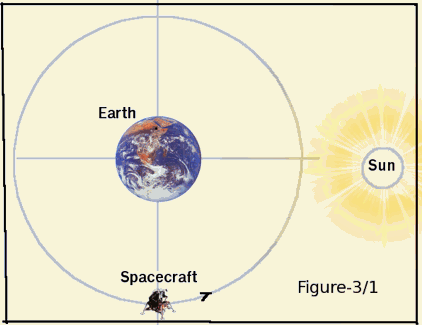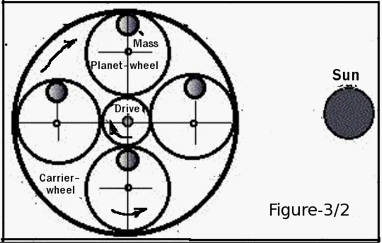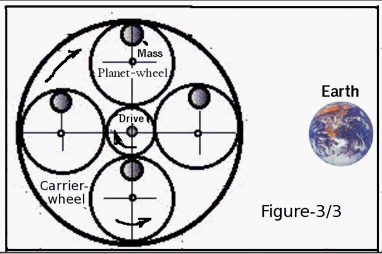Discussion - Spacecraft Control
Franz HeekeThe statement has been made, that a gravitation wheel (G-Wheel)
as described in article3 is "heavier
than at rest" as long as its rotation is being accelerated. Its
"weight" is lower, when its rotation is being decelerated as
described.
These effects, if true, can probably be used in spacecraft- control. Following ideas and considerations thus are up for discussion:
These effects, if true, can probably be used in spacecraft- control. Following ideas and considerations thus are up for discussion:

Figure-3.1 may display a spacecraft positioned in geostationary
orbit. There may be a G-Wheel running on board as sketched
below:

The carrier- (fly-) wheel of this G-Wheel (Figure-3/2) rotates
in shown direction with a rotational speed of say several thousand revs/min.
A central (sun-) wheel drives the planet wheels with eccentric masses
in such a way, that the center of mass of the G-Wheel is always above
the main axis of rotation. The eccentric masses, in this way, are continuously
being "lifted" against sun's gravitation, as in Figure-5/2 article3.
Sun's gravitation is pulling on the spacecraft and the eccentric masses with a force (F) of about 6 Milli-Newton. A power-input (P) of 0.1 Watt then is required for "lifting" one kg of eccentric mass with a "lifting speed" of about 17 m/s against sun's gravitation. Total energy input (W) over an operating period of say three hours then sums up to 1000 Ws (1000 J). That energy produces an acceleration of the G-Wheel on one hand, on the other hand a force (F), pushing the spacecrafit in direction toward the sun.
The before calculated amount of energy is very small. There is the obvious consideration, that friction losses within the G-Wheel may spoil the described effect. However, it might be possible to balance friction losses by means of an auxiliary drive. This auxiliary drive would keep the rotational speed of the G-Wheel within predetermined range, a flywheel on same axis, rotating in opposite direction, would take up reaction forces.
Sun's gravitation is pulling on the spacecraft and the eccentric masses with a force (F) of about 6 Milli-Newton. A power-input (P) of 0.1 Watt then is required for "lifting" one kg of eccentric mass with a "lifting speed" of about 17 m/s against sun's gravitation. Total energy input (W) over an operating period of say three hours then sums up to 1000 Ws (1000 J). That energy produces an acceleration of the G-Wheel on one hand, on the other hand a force (F), pushing the spacecrafit in direction toward the sun.
The before calculated amount of energy is very small. There is the obvious consideration, that friction losses within the G-Wheel may spoil the described effect. However, it might be possible to balance friction losses by means of an auxiliary drive. This auxiliary drive would keep the rotational speed of the G-Wheel within predetermined range, a flywheel on same axis, rotating in opposite direction, would take up reaction forces.
